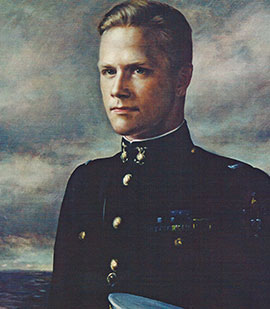Alexander "Sandy" Bonnyman Jr.
First Lieutenant, U.S. Marine Corps Reserves. For actions at Japanese-held Tarawa in the Gilbert Islands.
November 23, 1943

Accredited to New Mexico, Sandy Bonnyman was born on May 2, 1910, in Atlanta, GA, but the family soon moved to Knoxville, TN. His father was the president of Knoxville's Blue Diamond Coal Company, which was one of the largest coal mining companies in the U.S.
Sandy Bonnyman was movie-star handsome, played on Princeton's football team and studied engineering. But he dropped out of college and began flight training with the Army Air Corps. He later washed out of flight school, reportedly for repeatedly buzzing control towers, and was honorably discharged September 19, 1932.
After his discharge, he went to work with his father, and married Josephine Bell at San Antonio, TX, in 1933. In 1938 he acquired his own copper mine in the mountains of New Mexico.
Exempt from the draft because of both his age and his vital industry, he nevertheless chose to enlist in the Marines as a private. He first distinguished himself at Guadalcanal, receiving a battlefield commission for his exceptional leadership.
On Nov. 20, 1943, Bonnyman and his men were in Tarawa in the Gilbert Islands, attempting to come ashore under furious fire from Japanese shore batteries. Over three days, Bonnyman, who was supposed to be in a non-combat role directing operations, repeatedly braved overwhelming fire to lead men across the long, exposed Betio pier, organizing them into demolition teams to attack a bombproof Japanese emplacement that was raining fire on American troops. He directed his men in blowing up several enemy installations.
Bonnyman had spent several hours studying possible approaches to the huge, expertly camouflaged bunker and recognized that several air vents on top of the bunker might be vulnerable. He led a 21-man assault team in destroying the machine gun emplacements. A combat marine photographer with the group filmed the dangerous climb up the sandy slope of the bunker and the calculated use of flame-gunners, grenades, and rifle fire to destroy the bunker.
Bonnyman crawled 40 yards into enemy territory and placed demolitions in the opening of the heavily garrisoned installation. Withdrawing only for more ammunition, Bonnyman led his men in a renewed assault, repeatedly exposing himself to enemy fire as he stormed the bastion. He directed the placement of explosives in both entrances and stormed to the top of the installation. He flushed out more than 100 enemy soldiers, who were shot down instantly, and caused the death of another 150 Japanese troops inside the emplacement by dropping short-fused TNT charges down the air vents.
As the enemy poured out, he made a heroic stand atop the structure in the face of a fearless enemy charge, and killed three more before he fell. The final frames of the film show Bonnyman kneeling atop the bombproof, firing into the enemy, and turning to wave forward other marines before he fell, mortally wounded.
“By his dauntless fighting spirit, unrelenting aggressiveness and forceful leadership through three days of unremitting, violent battle, 1st Lt. Bonnyman inspired his men to heroic effort, enabling them to beat off the counterattack and break the back of hostile resistance.”
James F. Forrestal, then Secretary of the Navy, presented the Medal of Honor was presented to Bonnyman's teen-aged daughter, Frances, in Washington, D.C., January 22, 1947.
Bonnyman was declared Missing in Action or Buried at Sea, and his name appears on the Tablets of the Missing at the National Memorial Cemetery of the Pacific in Honolulu, HI. In 2008, however, just four days after families commemorated the 65th anniversary of the historic Battle of Tarawa, researchers announced that they had located the remains of 139 missing U.S. Marines killed there, with Bonnyman believed to be among them. Those remains are still unrecovered.
Both the Marine Corps League in Knoxville and the Pellissippi Parkway bridge over the Tennessee River are named for Bonnyman. At Princeton, his name is inscribed in the Nassau Hall Memorial Room, honoring World War II casualties, and a bronze star rests on the window ledge Blair Hall 54, his former dorm room.

